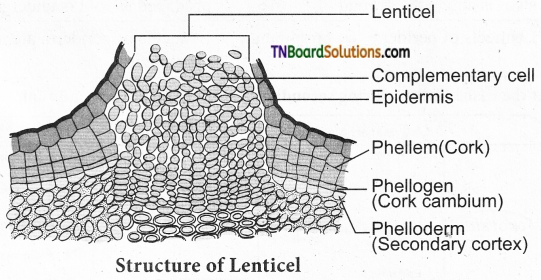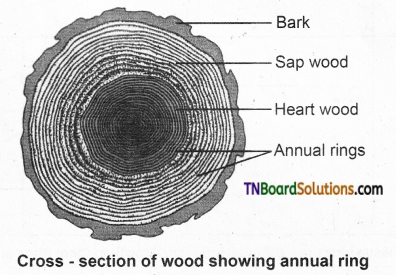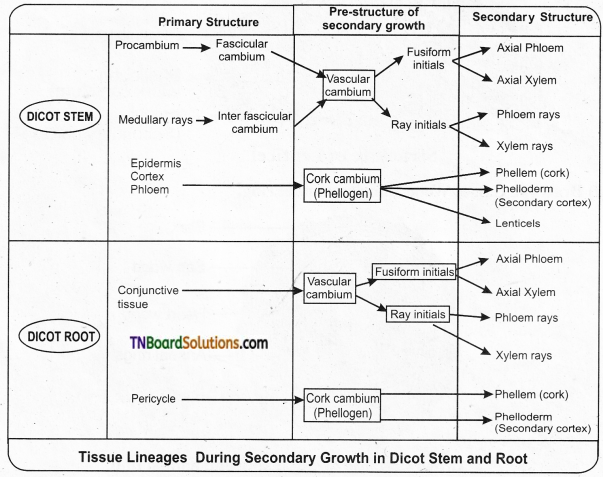Students get through the TN Board 11th Bio Botany Important Questions Chapter 10 Secondary Growth which is useful for their exam preparation.
TN State Board 11th Bio Botany Important Questions Chapter 10 Secondary Growth
Very short answer questions
Question 1.
Which meristem is responsible for secondary growth in dicots? Mention its types.
Answer:
Secondary growth in dicots is the responsibility of lateral meristems. They are vascular cambium and cork cambium.
Question 2.
Define vascular cambial ring.
Answer:
The interfascicular cambium joins with the intrafascicular cambium on both sides to form a continuous ring. It is called a vascular cambial ring.
Question 3.
Name the two types of initials developed by vascular cambium.
Answer:
Fusiform initials and ray initials.
Question 4.
What happens to the primary xylem and phloem during secondary growth?
Answer:
Due to the continued formation of secondary xylem and phloem through vascular cambial activity, both the primary xylem and phloem get gradually crushed.
![]()
Question 5.
Differentiate between porous and non-porous wood.
Answer:
| Porous Wood | Non-porous Wood |
| Common in angiosperms. | Common in gymnosperms. |
| Porous because it contains vessels. | Non-porous because it does not contain vessels. |
| Example: Morus | Example: Pinus |
Question 6.
State the types of the lateral meristem, their role in woody plants.
Answer:
| Types of Lateral meristem | Function |
| Vascular cambium | Produces xylem and Phloem |
| Cork cambium | Produces the bark of the tree |
Question 7.
Springwood – comment.
Answer:
In the spring season, cambium is very active and produces a large number of xylary elements having vessels/tracheids with a wide lumen. The wood formed during this season is called springwood or earlywood.
Question 8.
Define the term Dendroclimatoiogy.
Answer:
Dendroclimatology is a branch of dendrochronology concerned with constructing records of past climates and climatic events by analysis of tree growth characteristics, especially growth rings.
Question 9.
Which study does dendrochronology deal with?
Answer:
The determination of the age of a tree by counting the annual rings is called dendrochronology.
Question 10.
What do you mean by the term “Autumn Wood”?
Answer:
In winter, the cambium is less active and forms fewer xylary elements that have narrow vessels/tracheids and this wood is called autumn wood or latewood.
![]()
Question 11.
All growth rings are not annual. Why?
Answer:
Sometimes annual rings are called growth rings but all the growth rings are not annual. In some trees, more than one growth ring is formed within a year due to climatic changes.
Question 12.
State the location of tyloses.
Answer:
In many dicot plants, the lumen of the xylem vessels is blocked by many balloon-like ingrowths from the neighboring parenchymatous cells. These balloon-like structures are called tyloses.
Question 13.
List out the substances that are accumulated in tyloses.
Answer:
In fully developed tyloses, starchy crystals, resins, gyms, oils, tannins, or colored substances are found.
Question 14.
What are tylosoids?
Answer:
In angiosperms, the sieve tubes are blocked by tylose-like ingrowths from the neighbouring parenchymatous cells. Example: Bombax. These are called tylosoids.
Question 15.
Why the heartwood is unable to conduct water?
Answer:
The heartwood stops conducting, water. As vessels of the heartwood are blocked by tyloses, water is not conducted through them. Due to the presence of tyloses and their contents, the heartwood becomes colored, dead, and the hardest part of the wood.
Question 16.
Give the proper botanical term for heartwood and sapwood?
Answer:
Heartwood – Duramen and Sapwood – alburnum.
![]()
Question 17.
Write a brief note on Haematoxylin.
Answer:
Hematoxylin is a dye, obtained from the heartwood of Haematoxylum campechianum used to stain plant materials for observation under a microscope, especially the nucleus of the cell.
Question 18.
From where does the Canada balsam is obtained? Mention its use.
Answer:
Canada balsam is obtained from the resin ducts of a gymnospermic plant called Abies balsamea. It is used as a mounting medium for microscopic slide preparation.
Question 19.
List out the names of the plants and the types of bast fibers produced from that plant.
Answer:
| Plant Name | Bast Fibre |
| Linum ustitaissimum | Flax |
| Cannabis sativa | Hemp |
| Crotalaria juncea | Sun hemp |
| Corchorus capsularis | Jute |
Question 20.
What is periderm? Mention its components.
Answer:
The periderm is a protective tissue of secondary origin that replaces the epidermis and often the primary cortex. The periderm consists of phellem, phellogen, and phelloderm.
Question 21.
What is Phelloderm?
Answer:
Phelloderm (Secondary cortex) is a tissue resembling cortical living parenchyma produced centripetally (inward) from the phellogen as a part of the periderm of stems and roots in seed plants.
![]()
Question 22.
What are Lenticels? State its uses.
Answer:
Lenticel is raised opening or pore on the epidermis or bark of stems and roots. It is formed during secondary growth in stems.
Lenticel is helpful in the exchange of gases and transpiration called lenticular transpiration.
Question 23.
Define filling tissue.
Answer:
When phellogen is more active in the region of lenticels, a mass of loosely arranged thin-walled parenchyma cells is formed. It is called complementary tissue or filling tissue.
Question 24.
Enumerate any two commercial barks.
Answer:
(a) Cinchona bark used for antimalarial drug production.
(b) Cinnamon bark used as a spice.
Short answer questions
Question 1.
What do you understand by the term longitudinal growth?
Answer:
The plant organs originating from the apical meristems pass through a period of expansion in length and width. The roots and stems grow in length with the help of apical meristems. This is called primary growth or longitudinal growth.
Question 2.
Compare Intra fascicular & Inter fascicular cambium.
Answer:
| Intrafascicular cambium | Interfascicular cambium |
| Present inside the vascular bundles. | Present in between the vascular bundles. |
| Originates from the procambium. | Originates from the medullary rays. |
| Initially, it forms a part of the primary meristem. | From the beginning, it forms a part of the secondary meristem. |
![]()
Question 3.
Comment on Storied cambium.
Answer:
If the fusiform initials are arranged in horizontal tiers, with the end of the cells of one tier appearing at approximately the same level, as seen in the tangential longitudinal section (TLS), it is called storied (stratified) cambium.
Question 4.
How pseudo-annual rings are formed?
Answer:
Additional growth rings are developed within a year due to adverse natural calamities like drought, frost, defoliation, flood, mechanical injury, and biotic factors during the middle of a growing season, which results in the formation of more than one annual ring. Such rings are called pseudo- or false-annual rings.
Question 5.
List out the differences between springwood and autumn wood.
Answer:
| Spring Wood or Early Wood | Autumn Wood or Late Wood |
| The activity of the cambium is faster. | The activity of the cambium is slower. |
| Produces a large number of xylem elements. | Produces fewer xylem elements. |
| Xylem vessels/trachieds have wider lumen. | Xylem vessels/tracheids have narrow lumen. |
| Wood is lighter in color and has a lower density. | Wood is darker in color and has a higher density. |
Question 6.
Classify and explain the types of angiospermic woods based on the diameter of xylem vessels.
Answer:
On the basis of the diameter of xylem vessels, two main types of angiosperm woods are recognized.
- Diffuse porous woods: Diffuse porous woods are woods in which the vessels or pores are rather uniform in size and distribution throughout an annual ring. Example: Acer.
- Ring porous woods: The pores of the earlywood are distinctly larger than those of the latewood. Thus rings of wide and narrow vessels occur. Example: Quercus.
Question 7.
Differentiate between diffuse-porous wood and ring-porous wood.
Answer:
| Diffuse porous wood | Ring porous wood |
| This type of wood is formed where the climatic conditions are uniform. | This type of wood is formed where the climatic conditions are not uniform. |
| The vessels are more or less equal in diameter in any annual ring. | The vessels are wide and narrow within any annual ring. |
| The vessels are uniformly distributed throughout the wood. | The vessels are not uniformly distributed throughout the wood. |
![]()
Question 8.
Give an account on Phellogen.
Answer:
Phellogen (Cork Cambium):
It is a secondary lateral meristem. It comprises homogenous meristematic cells, unlike vascular cambium. It arises from the epidermis, cortex, phloem, or pericycle (extrastelar in origin). Its cells divide periclinally and produce radially arranged files of cells. The cells towards the outer side differentiate into phellem (cork) and those towards the inside as phellogen (secondary cortex).
Question 9.
Define the term Rhytidome.
Answer:
Rhytidome is a technical term used for the outer dead bark which consists of periderm and isolated cortical or phloem tissues formed during successive secondary growth. Example: Quercus.
Question 10.
Compare ring barks with scale barks.
Answer:
If the phellogen forms a complete cylinder around the stem, it gives rise to ring barks. Example: Quercus. When the bark is formed in overlapping scale-like layers, it is known as scale bark. Example: Guava.
Question 11.
Enumerate the beneficial aspects of bark.
Answer:
Bark protects the plant from parasitic fungi and insects, prevents water loss by evaporation, and guards against variations of external temperature. It is insect repellent, decay proof, fireproof and is used in obtaining drugs or spices. The phloem cells of the bark are involved in the conduction of food while secondary cortical cells involved in storage.
Question 12.
(i) Draw and label the structure of lenticel.
Answer:

(ii) Draw the C.S. of Wood showing the annual ring.
Answer:

![]()
Long answer questions
Question 1.
Differentiate between secondary growth in dicot stem and root.
Answer:
| Secondary growth in dicot stem | Secondary growth in dicot root |
| The cambial ring formed is circular in cross-section from the beginning. | The cambial ring formed is wavy in the beginning and later becomes circular. |
| The cambial ring is partially primary (fascicular cambium)and partially secondary (Interfascicular cambium) in origin. | The cambial ring is completely secondary in origin. |
| Generally, periderm originates from the cortical cells (extrastelar in origin). | Generally, periderm originates from the pericyle. (intrastelar in origin). |
| More amount of cork is produced as the stem is above the ground. | Generally, less amount cork is produced as the root is underground. |
| Lenticels of periderm are prominent. | Lenticels of periderm are not very prominent. |
Question 2.
Depict the tissue lineage during secondary growth in the dicot stem and root.
Answer:

![]()
Question 3.
List out the differences between Vascular cambium and cork cambium.
Answer:
| Vascular cambium | Cork cambium |
| Also called cambium. | Also called phellogen. |
| It arises from procambium and interfascicular parenchyma in stems and from conjunctive parenchyma in roots. | It arises from the epidermis, cortex, phloem, or pericyle in both stems and roots. |
| It comprises long fusiform and short ray initials. | It comprises homogenous cells. |
| It produces secondary phloem towards the outer side and secondary xylem towards the inner side. | It produces phellem(cork) towards the outer side and phelloderm (secondary cortex) towards the inner side. |
Question 4.
Differentiate between Phellem and Phelloderm.
Answer:
| Phellem (Cork) | Phelloderm (Secondary cortex) |
| It is formed on the outer side of phellogen. | It is formed on the inner side of the phellogen. |
| Cells are compactly arranged in regular tires and rows without intercellular spaces. | Cells are loosely arranged with intercellular spaces. |
| Protective in function. | As it contains chloroplast, it synthesizes and stores food. |
| Consists of non-living cells with suberized walls. | Consists of living cells, parenchymatous in nature and does not have suberin. |
| Lenticels are present. | Lenticels are absent. |
Question 5.
Differentiate between Heartwood and Sapwood.
Answer:
| Sap Wood (Alburnum) | Heart Wood (Duramen) |
| Living part of the wood. | The dead part of the wood. |
| It is situated on the outer side of the wood. | It is situated in the center part of the wood. |
| It is less colored. | It is dark in colored. |
| Very soft in nature. | Hard in nature. |
| Tyloses are absent. | Tyloses are present. |
| It is not durable and not resistant to microorganisms. | It is more durable and resists microorganisms. |
![]()
Question 6.
Why the study of Growth rings is significant?
Answer:
Importance of Studying Growth Rings:
- Age of wood can be calculated.
- The quality of timber can be ascertained.
- Radio-Carbon dating can be verified.
- Past climate and archaeological dating can be made.
- Provides evidence in forensic investigation.
Higher Order Thinking Skills (HOTs)
Question 1.
What do heartwood and sap wood stand for?
Answer:
Heartwood refers to the dark central part of the wood.
Sapwood refers to the pale peripheral part of the wood.
Question 2.
Arrange the following in the sequence you would find them in a plant starting from ‘ periphery-Phellem, Phellogen, phelloderm.
Answer:
Phellem (cork) → Phellogen (cork cambium) → Phelloderm (secondary cortex).
Question 3.
A transverse section of the trunk of a tree shows concentric rings known as growth rings.
How these rings are formed? Mention its significance.
Answer:
Growth rings denote the combination of earlywood and latewood formed during the spring season and winter season respectively and the rings are more evident due to the high density of latewood. Growth rings (annual rings) in a cut stem can be used to calculate and determine the age of a tree.
Question 4.
If one debarks a tree, what parts of the plant are being removed?
Answer:
The term bark refers to all the tissues outside the vascular cambium i.e., periderm, cortex, primary phloem, and secondary phloem. If a person debarks a tree all these layers of the plant are removed.
![]()
Question 5.
Given down is the list of commercial products obtained from plants. Mention the parts of the plant which are used to obtain them.
(a) Rubber (b) Cinnamon (c) Turpentine
Answer:
| Product | Plant Source |
| Rubber | Latex vessels of the inner bark of Hevea brasiliensis. |
| Cinnamon | The bark of Cinnamomum zeylanicum. |
| Turpentine | The resin obtained from the bark of Pinus. |
Choose the correct answer.
1. Longitudinal growth refers to ……….. .
(a) Primary growth
(b) Secondary growth
(c) Tertiary growth
(d) Abnormal growth
Answer:
(a) Primary growth
2. Secondary growth is absent in ………… .
(a) Gymnosperms
(b) Angiosperms
(c) Dicots
(d) Monocots
Answer:
(d) Monocots
![]()
3. Interfascicular cambium originates from ………… .
(a) Procambium
(b) Vascular cambium
(c) Pith
(d) Medullary rays
Answer:
(d) Medullary rays
4. ……….. is also called as wood.
(a) Primary xylem
(b) Primary Phloem
(c) Secondary xylem
(d) Pith
Answer:
(c) Secondary xylem
5. Soft wood lacks ………… .
(a) Tracheids
(b) Pith
(c) Vessels
(d) Medullary rays
Answer:
(c) Vessels
6. ……….. produces the primary plant body.
(a) Procambium
(b) Apical meristem
(c) Lateral meristem
(d) Vascular cambium
Answer:
(b) Apical meristem
7. Dendrochronology deals with determining the ………… .
(a) Growth of trees
(b) Age of trees
(c) Branching pattern of trees
(d) Growth and climatic influence on trees
Answer:
(b) Age of trees
8. Diffuse porous wood is seen in …………. .
(a) Quercus
(b) Maple
(c) Pinus
(d) Acer
Answer:
(d) Acer
![]()
9. The balloon-like swellings blocking the lumen of xylem vessels are called ………….. .
(a) Xyloses
(b) Callose
(c) Tyloses
(d) Tylosoids
Answer:
(c) Tyloses
10. Sapwood can also be termed as ……….. .
(a) Duramen
(b) Porous wood
(c) Phellogen
(d) Alburnum
Answer:
(d) Alburnum
11. Hematoxylin especialls stains ………… .
(a) Mitochondria
(b) Nucleus
(c) Golgi bodies
(d) Ribosomes
Answer:
(b) Nucleus
12. Sun hemp is obtained from ………… .
(a) Crotolaria iuncea
(b) Corchorus capsularis
(c) Linum ustitaissimum
(d) Cannabis sativa
Answer:
(a) Crotolaria iuncea
13. The non-living cork cells are with ………… walls.
(a) Lignified
(b) Suberized
(c) Cutinised
(d) Cellulose rich
Answer:
(b) Suberized
![]()
14. ………….. gives rise to the secondary cortex.
(a) Phelloderm
(b) Endoderm
(c) Phellogen
(d) Periderm
Answer:
(a) Phelloderm
15. Scale barks can be observed in …………. .
(a) Guava
(b) Quercus
(c) Coconut
(d) Neem
Answer:
(a) Guava
16. Which of the following is termed as Cork?
(a) Phellem
(b) Periderm
(c) Phellogen
(d) Phelloderm
Answer:
(a) Phellem
17. Polyderm is found in ………..
(a) Stem
(b) Roots
(c) Underground stem
(d) Both (a) and (c)
Answer:
(d) Both (a) and (c)
18. …………… are formed only during secondary growth.
(a) Stomata
(b) Endodermis
(c) Pith
(d) Lenticel
Answer:
(d) Lenticel
![]()
19. Turpentine is obtained from ………. species.
(a) Cinchona
(b) Acacia
(c) Pinus
(d) Cinnamomum
Answer:
(c) Pinus
20. Rubber is a ………..
(a) Latex
(b) Resin
(c) Alkaloid
(d) Drug
Answer:
(a) Latex